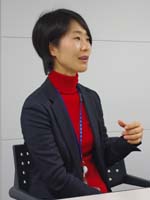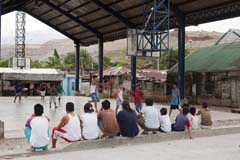InterviewJICA-RI Focus Vol.33 - Interview with Research Fellow Izumi Yamasaki
2016.03.02
Verifying Improvements in Learning Achievements and Employment Resulting from Educational Reform in the Philippines
The Philippines is currently implementing a large-scale educational reform. The biggest feature of the reform is the extension of the period of basic education (primary and secondary education), which has been only 10 years, to 12 years to meet typical international standards. Model schools have already introduced an additional two-year program, and among them JICA is supporting education at technical vocational high schools.

But does expanding vocational education and training at the secondary level lead to higher learning achievements and better results in employment? With the primary aim of answering this question, Research Fellow Izumi Yamasaki is pursuing a research “Vocational Education and Training in Secondary Education in the Philippines: Empirical Analysis on Schools, Graduates, Households and Labor Market” with her research team. We asked her about the objectives and background of the research, the expected results and the likely impact on policy.
Profile
Yamasaki specializes in the economics of education. She served as a consultant for the World Bank, an assistant professor at Wakayama University, and a lecturer at Kobe College before assuming her current position at JICA-RI.
- What are the background and objectives of your research?
In most countries the period of basic education is 12 years, but the Philippines has been the only country in Asia with just 10 years of basic education. The Philippines government has initiated an educational reform called the "K to 12 Program" to raise the period of basic education to 12 years, with the aims of developing basic cognitive abilities and skills and the capabilities required for lifelong learning, offering a global-standard high-school diploma qualification, providing education that meets the needs of industry and creating jobs.
Ahead of the nationwide extension in the 2016 academic year of the secondary education period from four to six years, the Philippines' Department of Education introduced a system of designated model schools in the 2012 academic year. JICA designated four of the model technical vocational high schools as pilot schools and has been implementing a "Technical Vocational High School Support Project." Specifically, JICA provides training to teachers, supplies facilities and equipment, prepares a school improvement plan for each school and builds stronger ties with industry.
For our research, we will analyze, by comparing the model schools with other schools, what kind of impact the extension of the education period has had on the students and graduates of the model schools. I believe my findings will be useful in the formulation of future education policy by the government.
- How did you conduct the survey?
We performed the interim survey between March and August 2015. We visited the homes of 2,200 graduates from a total of 29 schools (11 model technical vocational high schools, including the four pilot schools, and 18 non-model technical vocational high schools) and asked questions of them as well as parents/guardians. We also surveyed each school and companies around the school.

A survey is conducted of 2,200 graduates
The survey looked at characteristics of these subjects, such as graduates' final level of educational attainment, the high school and technical vocational course they had attended, whether they had found a job and the number of the days they had spent on internships while enrolled in high school as well as their parents' level of education and the household's income. It also covered schools and companies and included questions on the educational backgrounds of the teachers and the strengths of schools' ties with industry, and the salaries of employees and the required educational qualifications to become an employee. Altogether, there were hundreds of questions. According to the Philippines' Department of Education, this is the first survey of this kind in the Philippines, and the Department is therefore looking forward to seeing the results. I will be analyzing the results using the methods of the economics of education.
The economics of education is a field that employs the theories and analytical methods of economics to analyze a variety of issues related to education. In the U.S. it has over 50 years of history, but in Japan it is a field that still has few researchers. In Japan, many people still think "education outcomes cannot be quantified". However, empirical and quantitative data analysis is important for the formulation of education policy in maximizing outcomes with limited budgets and resources.
- Specifically, what are you going to analyze and how will you analyze it?
In the field of economics, production functions allow us to consider what combination of factors of production such as capital, technology, human resources and raw materials will maximize output. Applied to the education, the education production function approach allows us to consider how "school inputs" - such as teaching time, number and quality of teachers, equipment and class size and "non-school inputs" such as characteristics of a household (family), classmates, community and region - affect educational outcomes (cognitive abilities, employment, income, etc.). To perform analysis using an education production function, I will verify what kind of impact the school's resources and the quality of education in the case of Grades 11 - 12 students at model technical vocational high schools has on students and graduates. The research will analyze in particular the impact of school inputs such as (1) strength of ties between schools and industry, (2) characteristics of teachers and principals (their educational background, number of years of experience, whether they have experience at a private-sector company) and (3) investment in education (budget). I will also conduct a detailed analysis that takes into account characteristics of (1) household such as the educational level and incomes of parents, (2) classmates such as the average learning achievements of students at the same school and (3) the community such as average incomes.
I will also compare a group of graduates who attended a model technical vocational high school until the 12th grade with a group who graduated from high school after the 10th grade, analyzing them for differences in the rate of return to education (the impact on their incomes later), their probabilities of employment and degree of job satisfaction.
Through this research, I will verify the impact of extended education at the model technical vocational high schools has had on three areas. The first is the "impact on the degree of educational achievement and vocational abilities." I will investigate whether the investment of school resources has had a positive impact on learning achievements, rates of completion, repetition, and drop-outs, and passing rate of national examinations. The second is the "impact on employment." I will investigate the impact on job-finding rates, wages and job satisfaction. The third is the "impact of government policies," and I will verify whether initiatives at the pilot schools, such as the implementation of school improvement plans and the strengthening of the roles of industrial linkage coordinators and guidance counselors, have had a positive impact on the learning achievements and employment rates of students and graduates.
- What have the preliminary findings suggested?
I have to wait until my final analysis to draw a conclusion, but preliminary results show a positive impact on the employment of boys who completed grades 11 and 12 at a model technical vocational high school. This is probably because boys acquire skills required for manufacturing jobs such as welding, automotive and machine operation. Girls, on the other hand, often go on to take courses in cooking and food & beverage service, but these courses may not help them find jobs. Going forward, it will be necessary to look not just at differences between boys and girls, but to also carefully analyze differences between courses.
In addition, it is possible that the more capable the student is, the more likely they will go on to university or get a job rather than move on to their 11th or 12th year. It could also take some time before the results are seen in the labor market. To measure the results accurately, it will be necessary to examine more detailed data over a longer timeframe.
Furthermore, if certain schools perform better, it will be necessary to examine the reasons why with education production functions. Are such differences due to differences in the courses, in the quality of the teachers or in the number of days or quality of internships? Answering to these questions, I would like to make specific suggestions for what schools should work on.

Young Filipino playing basketball(Photo: JICA/Shinichi Kuno)
At the pilot schools JICA supplies the equipment required for lessons, which involves technical training, provides training to the principal and the teachers, assists with the preparation of school improvements plans and expands internship programs with local industry, particularly Japanese companies. I intend to confirm whether such initiatives are resulting in higher employment probabilities and incomes compared with other model schools.
- What are the advantages of empirically researching vocational education and training?
In recent years interest in initial vocational education and training has been increasing among international organizations such as the Organisation for Economic Co-operation and Development (OECD). However, not much research on the impact of vocational education and training has been done. A previous research has concluded that "general education offers a higher rate of return to education than vocational education and training," and vocational education and training have a history of being overlooked both academically and politically. Another reason for this may be that few policymakers and researchers have received vocational education or training.
During Japan's rapid economic growth, vocational education and training at the high-school level expanded at the demand of industry, and proved successful to some degree. The on the job training at Japanese companies is internationally well known, but the experience of vocational education and training as a part of formal education is not adequately recognized. Disseminating the insights from this research widely could help promote understanding of the significance and contribution to economic growth of vocational education and training at the secondary level.
- What do you think about the relationship between education and "quality growth?"
I have been interested in international cooperation, and have felt education and the economy form the foundation of society. When I worked for the World Bank, I learned how economic theory and econometrics can be useful for policy analysis. I also found out about impact evaluations, and realized how effective economics-based approaches can be. Then I thought of studying the economics of education further, to contribute to education development through these economics-based approaches.
Regarding "quality growth," education plays the role of bringing about "inclusiveness." Specifically, if everyone receives education, a highly-inclusive society can be realized, leading to eliminate social disparities. As the example of Japan in its high-growth era suggests, vocational education and training may contribute directly to economic growth.
Education also delivers resilience. By receiving education, people gain the strength to overcome any external shock they are confronted with. The skills obtained through vocational education and training and the knowledge acquired through education give people the ability to continue working and living whatever economic shocks, disasters and conflicts may occur.
I hope to continue using the economics of education as a foundation for tackling various educational challenges, such as vocational education and training and school administration, and to thereby contribute to the strengthening of education.

事業事前評価表(地球規模課題対応国際科学技術協力(SATREPS)).国際協力機構 地球環境部 . 防災第一チーム. 1.案件名.国 名: フィリピン共和国.

事業事前評価表(地球規模課題対応国際科学技術協力(SATREPS)).国際協力機構 地球環境部 . 防災第一チーム. 1.案件名.国 名: フィリピン共和国.

事業事前評価表(地球規模課題対応国際科学技術協力(SATREPS)).国際協力機構 地球環境部 . 防災第一チーム. 1.案件名.国 名: フィリピン共和国.

事業事前評価表(地球規模課題対応国際科学技術協力(SATREPS)).国際協力機構 地球環境部 . 防災第一チーム. 1.案件名.国 名: フィリピン共和国.

事業事前評価表(地球規模課題対応国際科学技術協力(SATREPS)).国際協力機構 地球環境部 . 防災第一チーム. 1.案件名.国 名: フィリピン共和国.
scroll